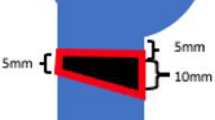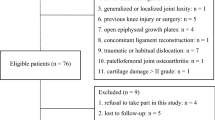Abstract
Purpose
It is generally agreed that surgical treatment is warranted for acute posterior cruciate ligament (PCL) avulsion fracture with displacement. However, the amount of displacement that warrants surgical treatment has not been defined. The purpose of this study was to determine the optimal cut-off value for displacement of posterior cruciate ligament avulsion fracture in determining non-operative treatment and to compare the results of non-operative treatment in acute isolated PCL avulsion fractures with non-operative treatment of acute PCL injury.
Methods
Between 2007 and 2017, 30 consecutive patients with acute isolated PCL avulsion fractures and 70 consecutive patients with acute isolated PCL injuries, all of whom underwent non-operative treatment (cast immobilization with > 2 years of follow-up) were retrospectively analyzed. Clinical scores including the International Knee Documentation Committee subjective score, Lysholm score, and Tegner activity score, as well as side-to-side differences on stress radiographs, were compared between the PCL avulsion fracture and PCL injury groups at the final follow-up. The failure rates of non-operative treatment were also compared. The predictive value of the amount of fracture displacement for successful non-operative treatment was calculated using area under the receiver operating characteristic curve (AUROC). The optimal cut-off of the amount of fracture displacement to determine non-operative treatment was based on the maximal sum of sensitivity and specificity.
Results
The two groups exhibited comparable clinical scores and mean side-to-side differences on stress radiographs. There were 5 (16.6%) failures of non-operative treatment in the PCL avulsion fracture group and 19 (27.1%) failures in the PCL injury group. (n.s) There was a significant positive correlation between the amount of initial avulsion fracture displacement and side-to-side difference in posterior stress radiographs at final follow up (P < 0.001). The optimal cut-off value for the amount of fracture displacement in PCL avulsion fracture to predict failure of non-operative treatment was 6.7 mm (AUROC = 1.0).
Conclusion
The outcomes of non-operative treatment of acute isolated PCL avulsion fractures were comparable to those of patients with acute isolated PCL injuries. Acute PCL avulsion injuries with displacement of less than 6.7 mm should be considered for non-operative treatment.
Level of evidence
IV.




Similar content being viewed by others
References
Bedi A, Musahl V, Cowan JB (2016) Management of posterior cruciate ligament injuries: an evidence-based review. J Am Acad Orthop Surg 24:277–289
Chandrasekaran S, Ma D, Scarvell JM, Woods KR, Smith PN (2012) A review of the anatomical, biomechanical and kinematic findings of posterior cruciate ligament injury with respect to non-operative management. Knee 19:738–745
Forkel P, Imhoff AB, Achtnich A, Willinger L (2019) [All-arthroscopic fixation of tibial posterior cruciate ligament avulsion fractures with a suture-button technique]. Oper Orthop Traumatol. https://doi.org/10.1007/s00064-019-00626-x
Forkel P, Lacheta L, von Deimling C, Lang J, Buchmann L, Imhoff AB et al (2020) Modified suture-bridge technique for tibial avulsion fractures of the posterior cruciate ligament: a biomechanical comparison. Arch Orthop Trauma Surg 140:59–65
Han F, Pearce CJ, Lee BCS (2019) Short-term clinical outcomes of arthroscopic fixation of displaced posterior cruciate ligament avulsion fractures with the use of an adjustable loop suspensory device. J Orthop Surg (Hong Kong) 27:2309499019849745
Hermanowicz K, Goralczyk A, Danowska K, Galazka D, LaPrade RF, Malinowski K (2019) All-Arthroscopic posterior cruciate ligament distal reattachment with extracortical fixation. Arthrosc Tech 8:e1425–e1430
Hooper PO 3rd, Bevan PJ, Silko C, Farrow LD (2018) A posterior approach to open reduction and internal fixation of displaced posterior cruciate ligament tibial osseous avulsions. JBJS Essent Surg Tech 8:e6
Hooper PO 3rd, Silko C, Malcolm TL, Farrow LD (2018) Management of posterior cruciate ligament tibial avulsion injuries: a systematic review. Am J Sports Med 46:734–742
Jung YB, Tae SK, Lee YS, Jung HJ, Nam CH, Park SJ (2008) Active non-operative treatment of acute isolated posterior cruciate ligament injury with cylinder cast immobilization. Knee Surg Sports Traumatol Arthrosc 16:729–733
Katsman A, Strauss EJ, Campbell KA, Alaia MJ (2018) Posterior cruciate ligament avulsion fractures. Curr Rev Musculoskelet Med 11:503–509
LaPrade CM, Civitarese DM, Rasmussen MT, LaPrade RF (2015) Emerging updates on the posterior cruciate ligament: a review of the current literature. Am J Sports Med 43:3077–3092
Marom N, Ruzbarsky JJ, Boyle C, Marx RG (2020) Complications in posterior cruciate ligament injuries and related surgery. Sports Med Arthrosc Rev 28:30–33
Pache S, Aman ZS, Kennedy M, Nakama GY, Moatshe G, Ziegler C et al (2018) Posterior cruciate ligament: current concepts review. Arch Bone Joint Surg 6:8–18
Rugg CM, Liu T, Zhang AL (2019) Arthroscopic primary bundle-specific posterior cruciate ligament repair with transosseous fixation. Arthrosc Tech 8:e911–e916
Sabat D, Jain A, Kumar V (2016) Displaced posterior cruciate ligament avulsion fractures: a retrospective comparative study between open posterior approach and arthroscopic single-tunnel suture fixation. Arthroscopy 32:44–53
Shahrulazua A, Rafedon M, Mohd Nizlan MN (2014) Sullivan JA (2014) Delayed compartment syndrome of leg and foot due to rupture of popliteal artery pseudoaneurysm following posterior cruciate ligament reconstruction. BMJ Case Rep 2:7
Shelbourne KD, Benner RW, Ringenberg JD, Gray T (2017) Optimal management of posterior cruciate ligament injuries: current perspectives. Orthop Res Rev 9:13–22
Song JG, Nha KW, Lee SW (2018) Open posterior approach versus arthroscopic suture fixation for displaced posterior cruciate ligament avulsion fractures: systematic review. Knee Surg Relat Res 30:275–283
Torisu T (1977) Isolated avulsion fracture of the tibial attachment of the posterior cruciate ligament. J Bone Joint Surg Am 59:68–72
Veltri DM, Warren RF (1993) Isolated and combined posterior cruciate ligament injuries. J Am Acad Orthop Surg 1:67–75
Wang D, Graziano J, Williams RJ 3rd, Jones KJ (2018) Nonoperative treatment of PCL injuries: goals of rehabilitation and the natural history of conservative care. Curr Rev Musculoskelet Med 11:290–297
Yoon JR, Park CD, Lee DH (2018) Arthroscopic suture bridge fixation technique with multiple crossover ties for posterior cruciate ligament tibial avulsion fracture. Knee Surg Sports Traumatol Arthrosc 26:912–918
Yoon KH, Kim EJ, Kwon YB, Kim SG (2019) Minimum 10-Year results of single- versus double-bundle posterior cruciate ligament reconstruction: clinical, radiologic, and survivorship outcomes. Am J Sports Med 47:822–827
Yoon KH, Park SW, Lee SH, Kim MH, Park SY, Oh H (2013) Does cast immobilization contribute to posterior stability after posterior cruciate ligament reconstruction? Arthroscopy 29:500–506
Zhao J, He Y, Wang J (2006) Arthroscopic treatment of acute tibial avulsion fracture of the posterior cruciate ligament with suture fixation technique through Y-shaped bone tunnels. Arthroscopy 22:172–181
Author information
Authors and Affiliations
Corresponding author
Ethics declarations
Conflict of interest
The authors declare that they have no competing interests.
Funding
No outside funding or financial support was received to undertake this study.
Ethical approval
Ethical approval was obtained from the Kyung Hee University Hospital Institutional Review Board (KHUH 2019-08-014) prior to the start of the study.
Informed consent
Formal consent was not required for this retrospective study.
Additional information
Publisher's Note
Springer Nature remains neutral with regard to jurisdictional claims in published maps and institutional affiliations.
Rights and permissions
About this article
Cite this article
Yoon, K.H., Kim, SG. & Park, JY. The amount of displacement can determine non-operative treatment in posterior cruciate ligament avulsion fracture. Knee Surg Sports Traumatol Arthrosc 29, 1269–1275 (2021). https://doi.org/10.1007/s00167-020-06175-2
Received:
Accepted:
Published:
Issue Date:
DOI: https://doi.org/10.1007/s00167-020-06175-2




